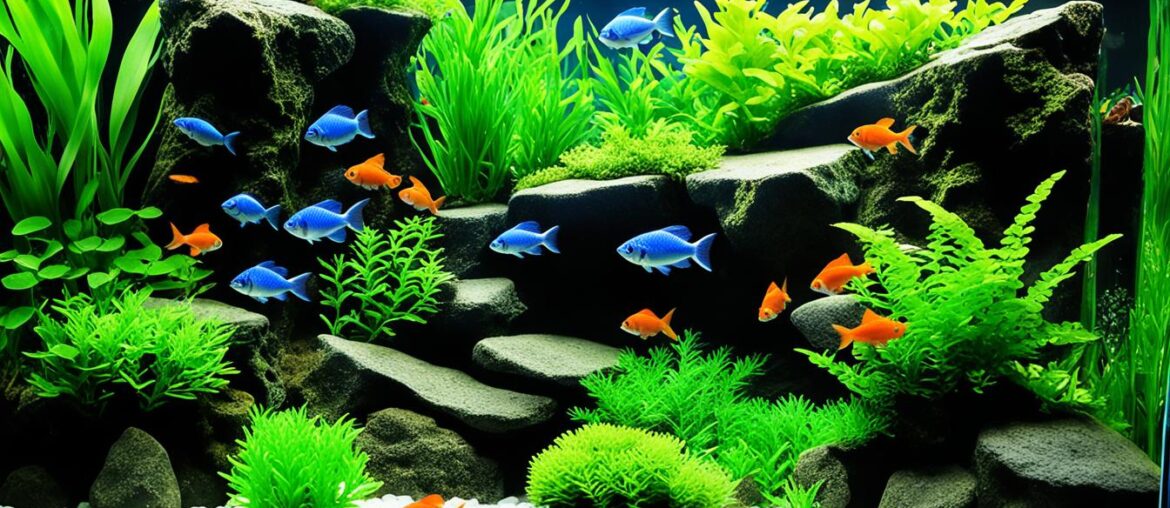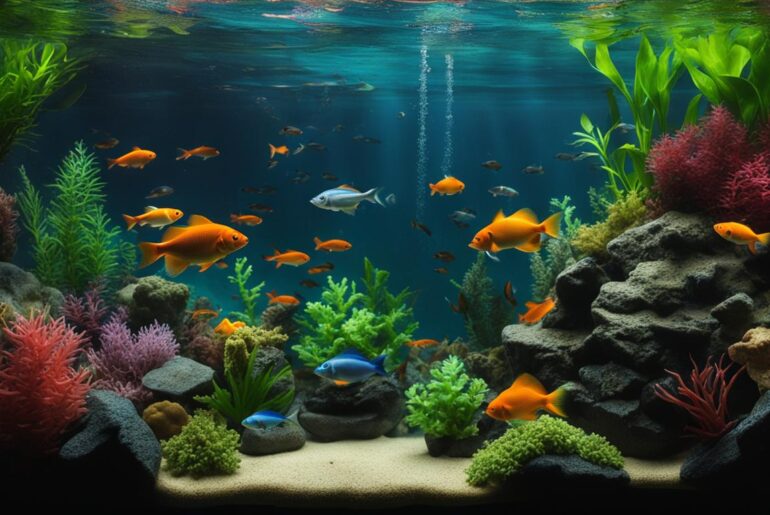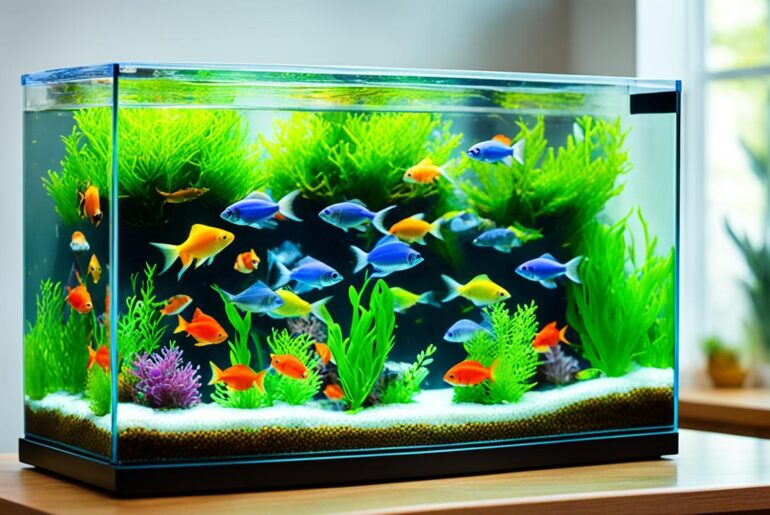Imagine stepping into a world of vibrant colors, graceful movements, and peaceful serenity. A world where you are the caretaker of a delicate ecosystem, responsible for the well-being of its inhabitants. This is the world of a freshwater aquarium, where every detail matters and every action you take can make a difference.
As an avid aquarium enthusiast, I have experienced firsthand the joy and fulfillment that comes with maintaining a thriving aquatic environment. But I have also witnessed the devastating consequences of neglecting this delicate balance. It was a lesson that left a lasting impression on me, one that I am eager to share with you today.
Freshwater aquariums are mesmerizing microcosms of life, but they require regular care to thrive. Water changes, in particular, play a vital role in maintaining the health and well-being of your aquarium inhabitants. Regular water changes remove accumulated waste, toxins, and excess nutrients, replenish essential minerals, and stabilize water parameters. They create a clean and balanced environment where your fish can flourish, plants can thrive, and the entire ecosystem can thrive in harmony.
Key Takeaways:
- Regular water changes are essential for maintaining a healthy freshwater aquarium ecosystem.
- Water changes remove waste, toxins, and excess nutrients, replenish essential minerals, and stabilize water parameters.
- Consistency and attention to detail are key to successful aquarium maintenance.
- Follow this guide for step-by-step instructions on performing water changes and determining the ideal frequency for your aquarium.
- By providing clean and stable water conditions, you create an environment where your fish and plants can thrive.
Importance of Regular Water Changes in Fish Tank
Regular water changes are crucial in maintaining the health and well-being of the fish and other inhabitants in your aquarium. They remove accumulated waste and toxins, replenish essential minerals, and ensure stable water parameters. By regularly changing the water, you create a clean and healthy environment for your fish to thrive.
Proper water changes play a key role in the overall maintenance of your fish tank. Here are some of the reasons why regular water changes are important:
- Removal of waste and toxins: Over time, fish waste, uneaten food, and decaying plants can build up in the aquarium, releasing harmful toxins like ammonia, nitrites, and nitrates. Regular water changes help eliminate these waste products, keeping the water clean and healthy for your fish.
- Replenishment of essential minerals: Water changes replace vital minerals and trace elements that are consumed or lost over time. These minerals are essential for the overall well-being and growth of your aquatic pets.
- Stable water parameters: Fluctuating water parameters can stress fish and make them more susceptible to diseases. By performing regular water changes, you help maintain stable parameters such as temperature, pH, and hardness, creating a more stable and comfortable environment.
- Prevention of stress and diseases: Dirty water can weaken the immune system of fish, making them more susceptible to stress and diseases. Regular water changes reduce the risk of stress-related issues and promote the overall health and longevity of your fish.
- Control of algae growth: Excessive nutrients, like nitrates and phosphates, can fuel algae growth in the aquarium. By removing these nutrients through water changes, you can prevent or reduce algae overgrowth, keeping your tank clean and aesthetically pleasing.
Regular water changes are the foundation of a successful aquarium. They provide a clean and stress-free environment, crucial for the well-being of your fish and other aquatic inhabitants.
Now that you understand the importance of regular water changes, let’s explore how to determine the ideal frequency and volume for your aquarium in the next section.
Determining the Ideal Water Change Frequency and Volume
Please refer to the next section for the complete content.
Determining the Ideal Water Change Frequency and Volume
When it comes to freshwater aquarium maintenance, determining the ideal water change frequency is crucial for the health and vitality of your aquatic ecosystem. The frequency and volume of water changes depend on several factors that contribute to the overall balance of your aquarium environment.
First and foremost, consider the size of your aquarium. Smaller tanks typically require more frequent water changes compared to larger ones due to their limited water volume and faster accumulation of toxins. Additionally, stocking density plays a significant role in determining water change frequency. A higher number of fish produces more waste, which necessitates more regular water changes.
The efficiency of your filtration system is another critical factor to consider. A well-maintained and properly sized filter can effectively remove toxins and waste, reducing the frequency of water changes. However, if your filter is inadequate or clogged, it may be necessary to perform more frequent water changes to maintain water quality.
Nutrient levels in your aquarium also impact the ideal water change frequency. In a heavily planted tank or one with high nutrient levels, more frequent water changes may be necessary to control algae growth and maintain a healthy balance. Conversely, a low-nutrient environment may require less frequent water changes.
Lastly, your overall maintenance routine and observation of water parameters and fish behavior can guide you in determining the optimal water change schedule. Regularly monitor water conditions using a reliable testing kit and observe your fish for any signs of stress or illness. If you notice sudden changes in behavior or water parameters, it might be an indication that a water change is needed.
As a general guideline, aim to perform water changes of 10-25% of the total volume every 1-2 weeks for most freshwater aquariums. This range provides a balance between waste removal and stability in the aquarium environment. However, remember to consider the specific needs of your aquarium based on the factors mentioned above for a more accurate water change schedule.
Summary:
- Consider aquarium size, stocking density, filtration system efficiency, and nutrient levels.
- Smaller tanks and higher stocking density require more frequent water changes.
- A well-maintained filtration system reduces the need for frequent water changes.
- High nutrient levels may necessitate more frequent water changes.
- Monitor water parameters and observe fish behavior to determine the optimal schedule.
- Aim for water changes of 10-25% every 1-2 weeks as a general guideline.
By carefully considering these factors and monitoring your aquarium, you can determine the ideal water change frequency and volume that will keep your aquatic inhabitants happy and healthy.
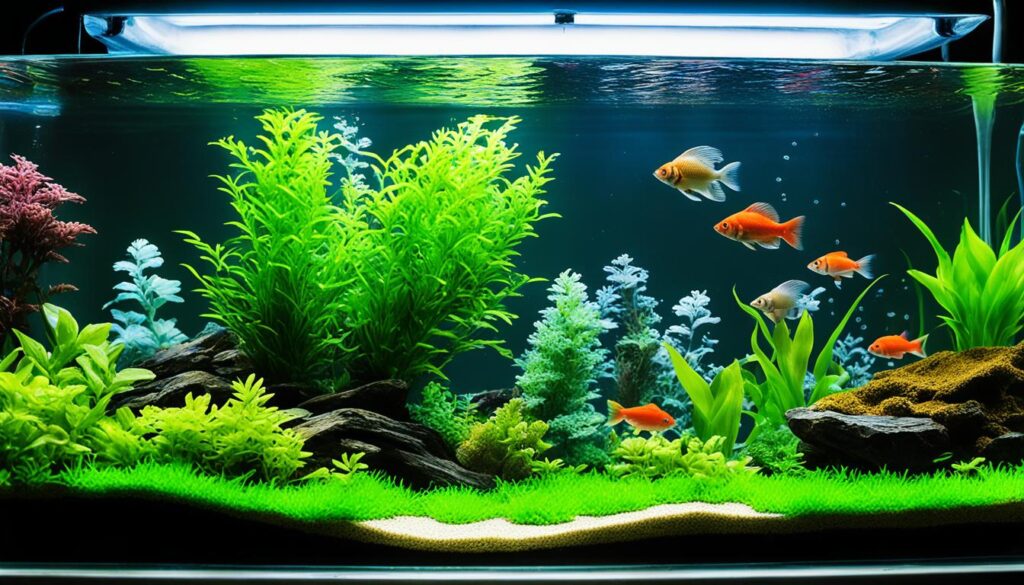
Step-by-Step Guide to Performing a Water Change
Performing a water change in your freshwater aquarium is a crucial maintenance task that helps keep your aquatic ecosystem healthy and thriving. Follow these step-by-step instructions to ensure a smooth and effective water change process:
- Gather the necessary supplies:
- Clean buckets
- Gravel vacuum or siphon
- Water conditioner
- Algae scraper
- Towels
- Fill clean buckets with tap water
- Add a suitable water conditioner to neutralize chlorine and other harmful substances
Before starting the water change process, ensure that all aquarium equipment, such as heaters, filters, and lights, is turned off to prevent any accidents or damage.
Use an algae scraper to remove any visible algae from the walls of the aquarium. Gently remove any debris or uneaten food that may have accumulated on the substrate or decorations.
Place the gravel vacuum or siphon into the tank and start draining the water. Be careful not to disturb the substrate or uproot any plants. Remove approximately 10-25% of the total water volume, depending on the specific needs of your aquarium.
Slowly pour the prepared replacement water into the tank. Match the temperature and water parameters as closely as possible to minimize stress on the fish and other aquatic inhabitants.
Add the recommended amount of water conditioner to the replacement water to neutralize any chlorine or harmful substances. Follow the instructions on the conditioner packaging for accurate dosing.
Once the water change is complete, turn on all the equipment, including heaters, filters, and lights. Monitor the tank for any signs of distress among the fish or other inhabitants.
Performing regular water changes is essential for maintaining water quality and promoting the overall health of your freshwater aquarium. By following this step-by-step guide, you can ensure that the water change process is efficient, effective, and stress-free for both you and your aquatic pets.
Remember to maintain a consistent water change frequency based on the needs of your aquarium. Regular water changes, along with proper filtration and a balanced maintenance routine, will contribute to a thriving and beautiful aquatic environment.
Aquarium Maintenance Schedule
Following a maintenance schedule is crucial for keeping your aquarium clean and healthy. Consistency and regularity in aquarium maintenance tasks are key to providing a thriving environment for your fish and other aquatic life. Here is a breakdown of the essential tasks to include in your freshwater aquarium maintenance schedule:
Daily Tasks
- Check equipment such as filters, heaters, and lights to ensure they are functioning properly.
- Observe your fish for any signs of illness, abnormal behavior, or stress.
- Remove any excess food or debris that may have accumulated in the tank.
- Top off the tank with treated water to compensate for evaporation.
Weekly or Bi-Weekly Tasks
- Clean the tank by removing any decorations and rinsing them with freshwater. Scrub the glass to remove algae buildup.
- Use a gravel vacuum to remove debris from the substrate and perform a partial water change of around 10-25%.
- Inspect and clean or replace filter media as needed.
- Test the water parameters, including pH, ammonia, nitrite, nitrate, phosphate, and water hardness.
Monthly Tasks
- Perform a more comprehensive water test to ensure the overall health of your aquarium. Use a reliable water testing kit to check for any potential imbalances or issues.
- Adjust water parameters if necessary, based on the test results. This may involve using water conditioners, pH buffers, or other appropriate treatments to maintain optimal conditions.
- Monitor and maintain the overall health of your fish, plants, and other inhabitants. Address any signs of illness, disease, or stress promptly.
By following a well-planned maintenance schedule, you can create a clean and stable environment for your freshwater aquarium. Consistency in performing these tasks will minimize the risk of water quality issues, promote the long-term well-being of your aquatic pets, and ensure the visual appeal of your aquarium.
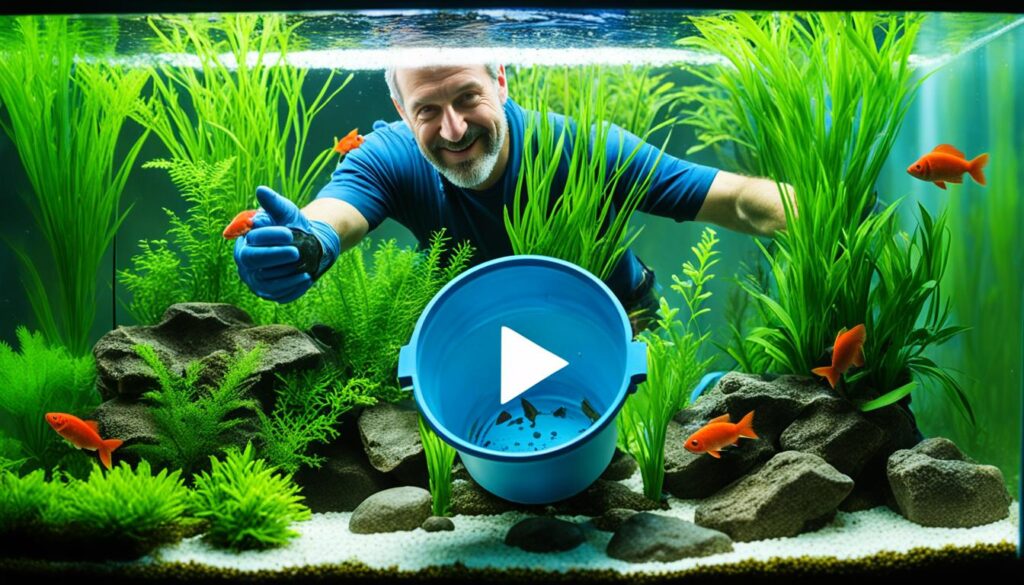
| Maintenance Task | Frequency |
|---|---|
| Check equipment | Daily |
| Observe fish | Daily |
| Remove excess food | Daily |
| Top off with treated water | Daily |
| Clean tank and decorations | Weekly |
| Gravel vacuum and partial water change | Weekly |
| Inspect and clean or replace filter media | Weekly |
| Water parameter testing | Weekly |
| Comprehensive water test | Monthly |
| Adjust water parameters | Monthly |
| Monitor overall health | Monthly |
How to Clean a Fish Tank
Cleaning your fish tank regularly is crucial for preventing the buildup of hazardous chemicals, grime, and contaminants that can harm your aquatic ecosystem. By following a few simple steps and using the right tools, you can ensure a clean and healthy environment for your fish and plants.
Gather the Necessary Tools
Before you begin the cleaning process, gather the following tools:
- Gravel vacuum
- Algae scrubber
- Filter brush
- Acrylic-safe cleaner
- Scissors (for trimming plants)
Step-by-Step Cleaning Process
- Start by washing your hands and forearms thoroughly to prevent any contaminants from entering the tank.
- Unplug all filters, lights, and any other electrical equipment connected to the tank to ensure your safety.
- Using a gravel vacuum, remove a portion of the water from the tank. Make sure to follow the recommended water change frequency for your specific freshwater aquarium.
- Next, clean the non-living decor items outside the tank using an acrylic-safe cleaner. Rinse them thoroughly before placing them back into the tank.
- Scrub the glass walls of the tank using an algae scrubber to remove any algae buildup. Be gentle to avoid scratching the glass.
- Use the gravel vacuum to vacuum the substrate, removing any debris or waste that has settled. Move the gravel vacuum in a slow and steady motion to avoid disturbing the fish or plants.
- Rinse the filter media in the removed tank water to remove any accumulated waste and debris.
- Finally, add replacement water to the tank. Make sure to treat the water with a suitable water conditioner to remove chlorine and other harmful substances. Gradually add the replacement water to match the temperature and water parameters of the tank.
By following these steps, you can maintain a clean and healthy fish tank that provides the best possible living conditions for your aquatic inhabitants.

Regular tank cleaning is essential for the health and well-being of your fish and plants. By incorporating these cleaning techniques into your freshwater tank maintenance routine, you can enjoy a vibrant and thriving aquarium environment.
Testing Aquarium Water Quality
Regular testing of the water quality in your aquarium is crucial for maintaining a healthy environment for your fish and plants. By monitoring key parameters, such as pH, ammonia, nitrite, nitrate, phosphate, and water hardness, you can detect any imbalances or issues and take appropriate action to rectify them.
A variety of testing kits are available to help you accurately measure these parameters. These kits typically include test strips, liquid reagents, or digital meters that provide instant results. Here’s a breakdown of the essential parameters to test and their significance:
pH Levels:
The pH level measures how acidic or alkaline the water is. It’s important to maintain a stable pH range suitable for your fish and plants. Most freshwater aquariums thrive in a slightly acidic to neutral (pH 6.5-7.5) range. Some species, like African cichlids, prefer more alkaline conditions. Regular testing allows you to adjust the pH if necessary.
Ammonia:
Ammonia is highly toxic to aquatic life, and even low levels can be harmful. It is primarily produced by fish waste and decaying organic matter. Regular testing ensures ammonia levels are kept at zero or close to zero, promoting a healthy environment for your aquatic inhabitants.
Nitrite:
Nitrite is another toxic compound that can accumulate in your aquarium. It forms as a byproduct of the breakdown of ammonia by beneficial bacteria. Monitoring nitrite levels is crucial, as elevated levels can harm fish and impair their ability to transport oxygen.
Nitrate:
Nitrate is the final byproduct of the nitrogen cycle and is less toxic than ammonia and nitrite. However, high nitrate levels can still stress fish, contribute to algae growth, and adversely affect plant growth. Regular nitrate testing helps you maintain optimal levels through water changes and other methods.
Phosphate:
Phosphate is a nutrient that can fuel excessive algae growth if present in high concentrations. Testing for phosphate levels allows you to identify potential sources of excess phosphate, such as overfeeding or poor filtration, and take corrective action to prevent algae outbreaks.
Water Hardness:
Water hardness refers to the concentration of dissolved minerals, such as calcium and magnesium, in the water. Different fish species have specific preferences for water hardness levels. Testing the hardness helps you ensure the water conditions are suitable for your fish, preventing potential health issues and stress.
Based on the test results, you can swiftly address any imbalances or issues to preserve the health and well-being of your aquarium inhabitants. Take corrective measures like adjusting pH levels, performing water changes, enhancing filtration, introducing beneficial bacteria, or modifying feeding habits to restore water quality.
Regular monitoring and testing of the water quality are essential components of a comprehensive freshwater aquarium maintenance schedule. By maintaining optimal water conditions, you provide a clean and healthy environment that promotes the longevity and vibrancy of your fish and plants.
Essential Aquarium Water Quality Parameters
| Parameter | Acceptable Range | Significance |
|---|---|---|
| pH | 6.5-7.5 | Determines ideal acidity/alkalinity for aquatic life |
| Ammonia | 0 ppm | High toxicity to fish |
| Nitrite | 0 ppm | High toxicity to fish, disrupts oxygen transport |
| Nitrate | Below 20 ppm | Elevated levels stress fish and promote algae growth |
| Phosphate | Below 0.5 ppm | High levels fuel excessive algae growth |
| Water Hardness | Varies by species | Affects fish health and biochemical processes |
Regularly testing your aquarium water quality enables you to identify potential issues before they become severe and take timely action. By maintaining optimal parameters, you create a thriving and harmonious aquatic ecosystem for your beloved fish and plants.
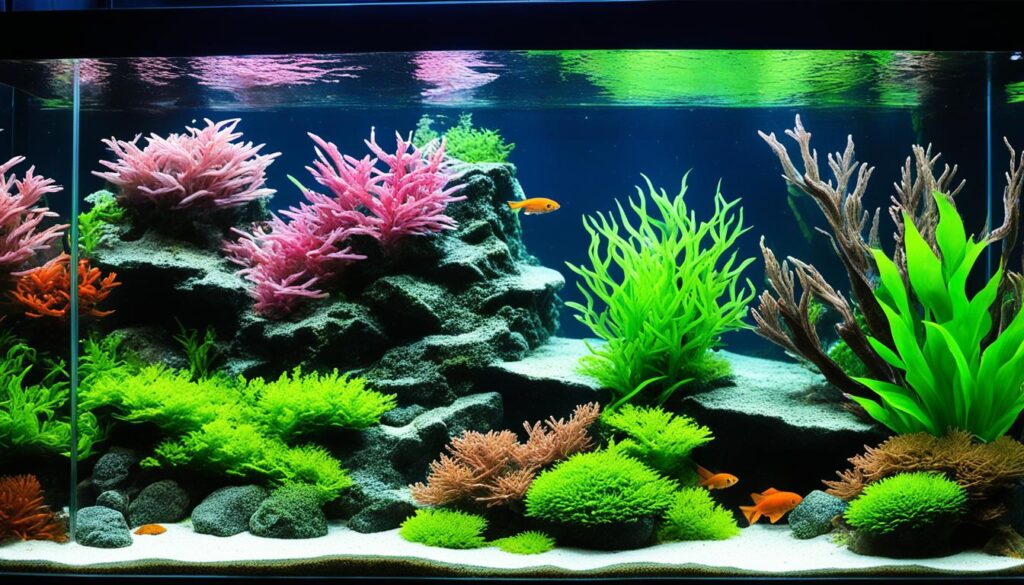
How to Fix Water Parameter Imbalances
If the water test results show imbalances in pH, ammonia, nitrite, nitrate, phosphate, or water hardness levels, there are a few corrective measures that can be taken to ensure a healthy freshwater aquarium ecosystem.
Low pH Levels: Adding crushed coral or dolomite gravel, limestone, or coral rock can help raise and buffer the pH levels in your aquarium.
High pH Levels: Reduce high pH levels by incorporating driftwood or introducing peat moss or peat pebbles with the filter to naturally lower the pH.
Ammonia Levels: To lower ammonia levels, regular tank cleaning, improving filtration, and adding beneficial bacteria can be effective in reducing ammonia buildup.
Nitrite, Nitrate, and Phosphate Levels: High levels of nitrite, nitrate, and phosphate can be addressed through regular tank cleaning, efficient filtration, introducing more air circulation, adding beneficial bacteria, and controlling feeding habits.
By addressing these imbalances, you can create a more stable and healthy environment for your aquarium inhabitants.
| Imbalance | Solution |
|---|---|
| Low pH Levels | Adding crushed coral, dolomite gravel, limestone, or coral rock |
| High pH Levels | Using driftwood or incorporating peat moss or peat pebbles |
| Ammonia Levels | Cleaning tank, improving filtration, adding beneficial bacteria |
| Nitrite, Nitrate, and Phosphate Levels | Regular cleaning, efficient filtration, introducing air, adding beneficial bacteria, controlling feeding habits |
Regular monitoring of water parameters and taking appropriate corrective measures will help maintain a balanced and thriving freshwater aquarium.
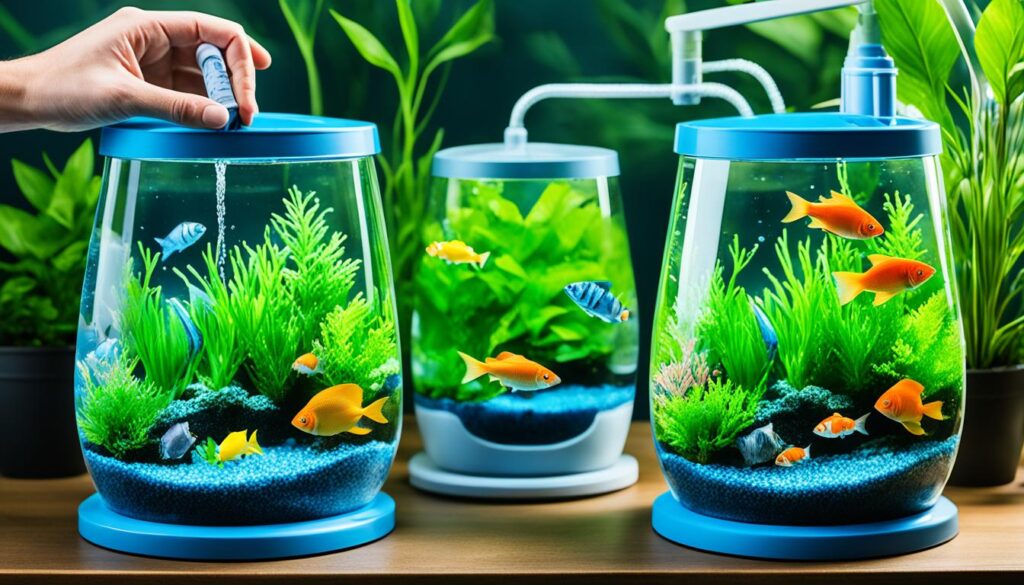
Importance of Dechlorinating Water
When it comes to maintaining a healthy and thriving freshwater aquarium, dechlorinating water is a crucial step that should never be overlooked. Tap water commonly contains chlorine, a chemical that can be harmful to fish and other aquatic life. By removing chlorine and other heavy metals from the water column, you can create a safe and stable environment for your aquarium inhabitants.
One effective way to dechlorinate water is by using a trusted dechlorinator such as the SL Aqua Black More Stabilizer. This product is specifically designed to eliminate chlorine while preserving the beneficial bacteria needed for a thriving aquarium ecosystem. Adding the correct amount of dechlorinator to your tank is essential, and always follow the manufacturer’s instructions for best results.
Before adding the dechlorinated water to your aquarium, it’s equally important to ensure that the bucket or container you use is clean and free from any residues or contaminants. Rinse it thoroughly to prevent any unwanted substances from entering your aquarium during the water change process.
Additionally, it’s crucial to match the temperature of the replacement water to the existing tank water. Rapid temperature changes are stressful for fish and can negatively impact their health. By maintaining a consistent water temperature, you provide a comfortable and stable environment for your aquatic pets.
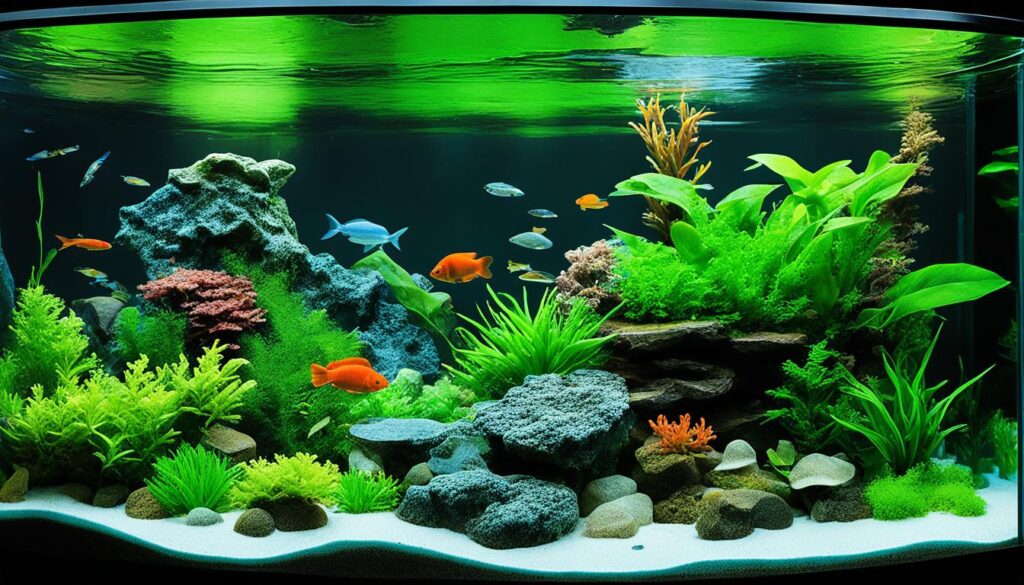
The importance of dechlorinating water cannot be overstated. It ensures the safety and well-being of your fish and other aquatic life, helping you maintain a healthy and thriving ecosystem. By following proper dechlorination procedures, cleaning your equipment, and maintaining a regular freshwater tank water change frequency, you are taking essential steps to create a successful freshwater aquarium.
Monitoring Water Temperature During Water Changes
Rapid temperature changes can be stressful and harmful to fish and other aquatic life. Ensuring minimal temperature change during water changes is important. Before adding new dechlorinated water, set a heater in the water to match the tank’s temperature or leave the container of new water in the same room as the tank for a few hours to equalize temperatures. Maintaining a consistent water temperature helps prevent stress-related issues in the aquarium.
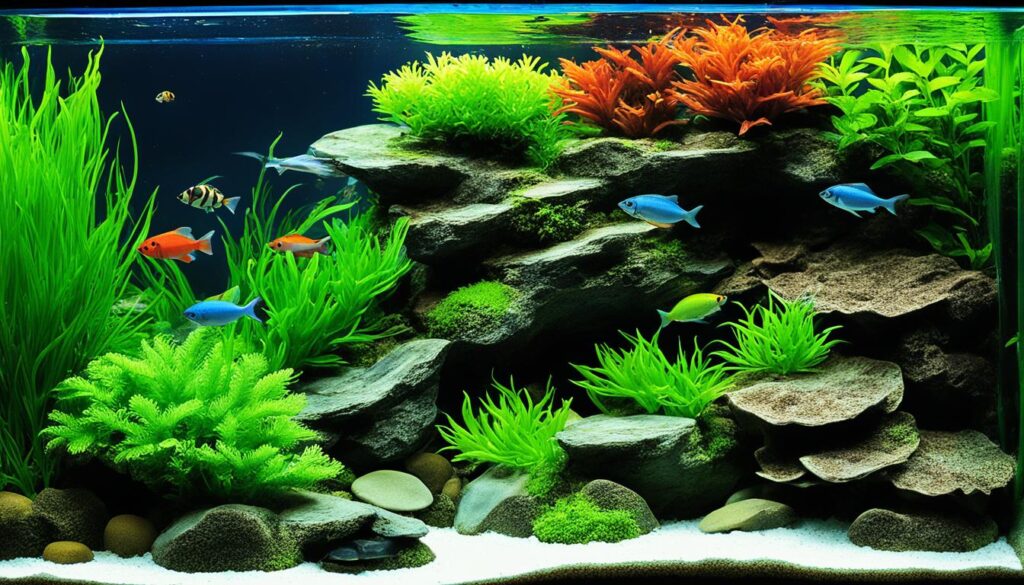
“Maintaining the right water temperature during water changes is crucial for the well-being of your fish.”
When performing a water change in your aquarium, it’s essential to consider the temperature of the replacement water. Fish and other aquatic organisms are highly sensitive to rapid temperature fluctuations, which can lead to stress and adverse health effects. By taking the necessary precautions, you can ensure a smooth and stress-free water change process.
Why is maintaining the water temperature important?
Abrupt temperature changes can cause stress and put your fish at risk. Sudden drops or increases in temperature can weaken their immune system, making them more susceptible to diseases. Additionally, temperature fluctuations can disrupt their natural behavior and breeding cycles.
By monitoring and maintaining a consistent water temperature during water changes, you provide a stable and comfortable environment for your fish, promoting their overall well-being. This is particularly crucial for sensitive species that require specific temperature ranges for optimal health.
Tips for maintaining consistent water temperature during water changes:
- Use a heater: Before adding the dechlorinated water, set a heater in the new water to match the temperature of your aquarium. This ensures that the replacement water is at the same temperature as the existing water, minimizing stress for your fish.
- Equalize temperatures: If you don’t have a heater, you can leave the container of new water in the same room as the aquarium for a few hours. This allows the water to gradually adjust to the room temperature, reducing the temperature difference when added to the tank.
By following these simple steps, you can maintain a consistent water temperature and provide a stress-free environment for your fish during water changes. Remember, attention to detail and proper care are essential for the well-being of your aquarium inhabitants.
Easy 5-Step Water Change Guide
Performing a water change can be made easier with a simple 5-step guide. By following these steps, you can maintain a clean and healthy aquarium environment for your fish and plants.
Step 1: Prepare New Tank Water
Before starting the water change process, prepare the replacement water. Fill clean buckets with tap water and add a suitable water conditioner, like SL Aqua Black More Stabilizer, to remove harmful substances and ensure the safety of your aquarium inhabitants.
Step 2: Turn Off Equipment
Prior to removing any water from the tank, turn off all electrical equipment such as heaters, filters, and lights. This prevents accidental damage and ensures the safety of both you and your aquarium inhabitants.
Step 3: Clean the Tank
With the equipment turned off, use an algae scraper or a clean sponge to remove any algae buildup from the glass surfaces. You can also take this opportunity to remove any debris or uneaten food from the tank.
Step 4: Siphon Out Old Water and Vacuum the Gravel
Next, use a gravel vacuum or siphon to remove a portion of the old water from the tank. Place the vacuum into the gravel and gently move it around to clean away any accumulated waste. This helps maintain water quality and prevent the buildup of harmful substances.
Step 5: Add Replacement Water and Prime the Filter
Slowly add the pre-conditioned replacement water into the tank, making sure to match the temperature and water parameters as closely as possible. Once the water is added, prime the filter by following the manufacturer’s instructions. This ensures that the filtration system is functioning properly and ready to keep your aquarium clean.
Following this simple 5-step water change guide will help you maintain a clean and healthy environment for your freshwater aquarium. Remember, consistency and attention to detail are key in achieving successful aquarium maintenance.
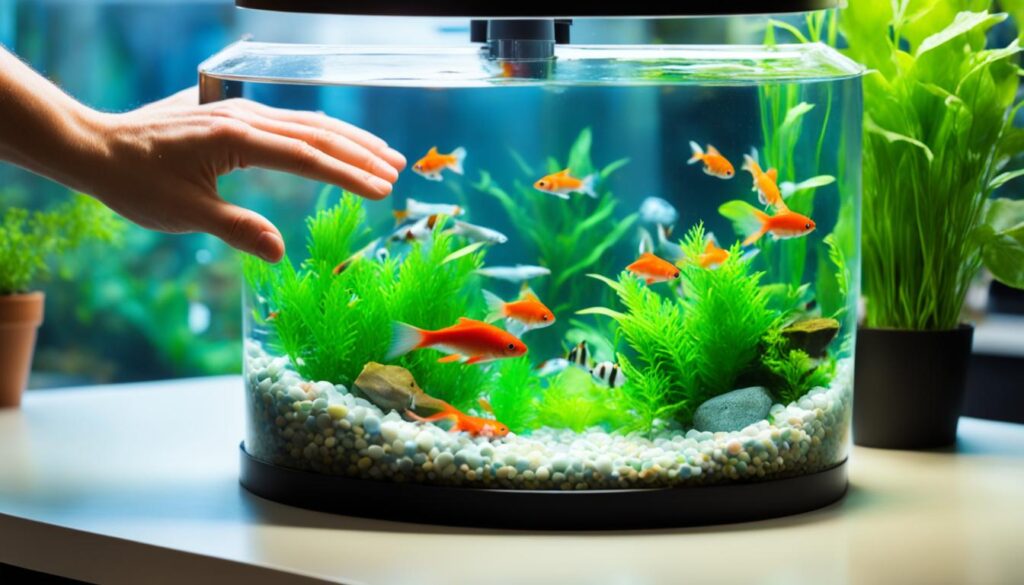
| Tank Size | Ideal Frequency | Water Change Volume |
|---|---|---|
| 10-20 gallons | Weekly | 10-25% |
| 30-50 gallons | Bi-weekly | 10-25% |
| 50+ gallons | Monthly | 10-25% |
Remember, these are general recommendations, and the frequency and volume of water changes may vary depending on the specific needs of your aquarium. Regular monitoring of water parameters and observing the behavior of your fish will help determine the optimal water change schedule for your setup.
Conclusion
Regular water changes are vital for the health and well-being of your freshwater aquarium. As an aquarium enthusiast, I have learned that following a proper water change routine, monitoring water parameters, and maintaining a consistent maintenance schedule are essential elements of effective aquarium care. By providing clean and stable water conditions for your fish and other inhabitants, you create an environment where they can thrive and flourish.
Consistency and attention to detail are key to maintaining a healthy and balanced aquatic ecosystem. The best water change schedule for your aquarium depends on factors such as tank size, stocking density, and filtration system efficiency. By closely observing your aquarium’s behavior and regularly testing water parameters, you can determine the optimal frequency of water changes.
Remember, happy and healthy fish require a clean environment. By performing regular water changes, you remove accumulated waste and toxins, replenish essential minerals, and ensure stable water parameters. So, keep up with your aquarium maintenance routine and enjoy the rewards of a beautiful and thriving underwater world. Happy aquarium keeping!
FAQ
What is the importance of regular water changes in a fish tank?
Regular water changes are crucial in maintaining the health and well-being of the fish and other inhabitants in your aquarium. They remove accumulated waste and toxins, replenish essential minerals, and ensure stable water parameters. Water changes help prevent stress, diseases, and algae overgrowth. By regularly changing the water, you create a clean and healthy environment for your fish to thrive.
How often should I change the water in my freshwater aquarium?
The frequency and volume of water changes depend on various factors, including aquarium size, stocking density, filtration system efficiency, nutrient levels, and overall maintenance routine. As a general guideline, aim to perform water changes of 10-25% of the total volume every 1-2 weeks for most freshwater aquariums. However, closely monitoring water parameters and observing the behavior of your aquarium inhabitants will help determine the optimal water change schedule for your specific setup.
What are the steps to performing a water change in a freshwater tank?
Performing a water change involves several steps to ensure a smooth and effective process. First, gather the necessary supplies, including clean buckets, a gravel vacuum or siphon, water conditioner, algae scraper, and towels. Prepare replacement water by filling clean buckets with tap water and adding a suitable water conditioner to neutralize chlorine and other harmful substances. Turn off equipment, remove debris and algae from the tank, drain water using a gravel vacuum or siphon, and add replacement water gradually while matching temperature and water parameters. Treat the water with conditioner and restart equipment.
What is an appropriate aquarium maintenance schedule?
Following a maintenance schedule is crucial for keeping your aquarium clean and healthy. Daily tasks include checking equipment, observing fish for any signs of illness, removing excess food, and topping off the tank with treated water. Weekly or bi-weekly tasks include cleaning the tank, gravel vacuuming, scrubbing the glass, and replacing a portion of the water. Monthly tasks include testing the water quality for pH, ammonia, nitrite, nitrate, phosphate, and water hardness levels.
How do I clean a fish tank properly?
Cleaning your fish tank regularly helps prevent the buildup of hazardous chemicals, grime, and contaminants. Tools such as a gravel vacuum, algae scrubber, filter brush, acrylic-safe cleaner, and scissors (for plants) can make the cleaning process easier and more effective. Steps to deep cleaning a fish tank include washing hands and forearms, unplugging filters and lights, removing a portion of the water, cleaning non-living decor, scrubbing the glass, vacuuming the gravel, rinsing filter media, and adding replacement water with treated water.
How do I test the water quality in my aquarium?
Testing the water quality in your aquarium is essential for maintaining a healthy environment for your fish and plants. Testing kits can measure parameters like pH, ammonia, nitrite, nitrate, phosphate, and water hardness. Regular testing helps monitor water conditions and detect any imbalances or issues. Based on the test results, corrective actions can be taken to adjust pH levels, lower ammonia, nitrite, nitrate, and phosphate levels, and address water hardness levels.
How can I fix water parameter imbalances in my aquarium?
If water test results reveal imbalances in pH, ammonia, nitrite, nitrate, phosphate, or water hardness levels, certain corrective measures can be taken. For low pH levels, adding crushed coral or dolomite gravel, limestone, or coral rock can raise and buffer the pH. High pH levels can be reduced by using driftwood or incorporating peat moss or peat pebbles with the filter. To lower ammonia, cleaning the tank, improving filtration, and adding beneficial bacteria can help. High nitrite, nitrate, and phosphate levels can be addressed through regular cleaning, filtration, introducing more air, adding beneficial bacteria, and controlling feeding habits.
Why is it important to dechlorinate water before adding it to the aquarium?
Tap water contains chlorine, which is harmful to fish and other aquatic life. Dechlorinating water before adding it to the aquarium is crucial to protect the livestock and maintain a healthy ecosystem. Using a dechlorinator like SL Aqua Black More Stabilizer helps remove chlorine and other heavy metals from the water column while ensuring the safety of the fish and preserving beneficial bacteria. Properly cleaning the bucket, adding the correct amount of dechlorinator, and matching the water temperature are essential steps in the water change process.
How can I monitor water temperature during water changes?
Rapid temperature changes can be stressful and harmful to fish and other aquatic life. Ensuring minimal temperature change during water changes is important. Before adding new dechlorinated water, set a heater in the water to match the tank’s temperature or leave the container of new water in the same room as the tank for a few hours to equalize temperatures. Maintaining a consistent water temperature helps prevent stress-related issues in the aquarium.
What are the steps to perform a water change in a freshwater tank?
Performing a water change can be made easier with a simple 5-step guide. Preparation of new tank water, turning off equipment, cleaning the tank, siphoning out old water, vacuuming the gravel, rinsing filter media, placing decor back, adding replacement water, and priming the filter are the key steps in a successful water change. Taking the time to perform these steps correctly helps maintain a clean and healthy aquarium environment for your fish and plants.
